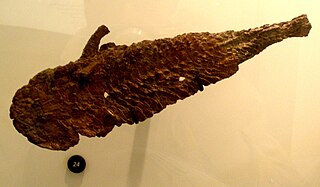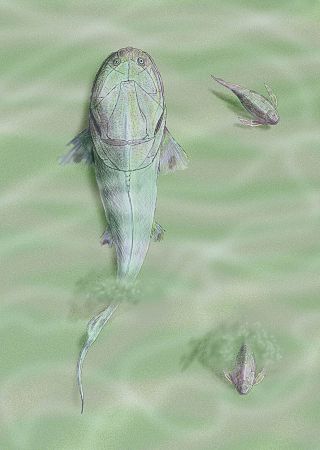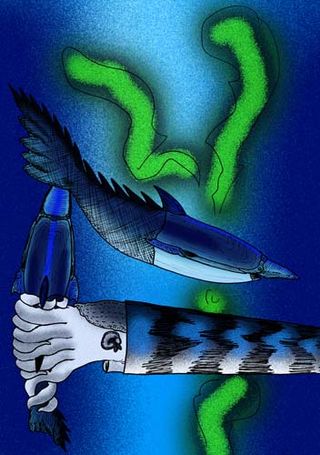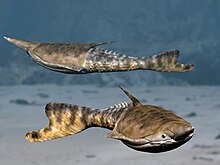
The Devonian is a geologic period and system of the Paleozoic era during the Phanerozoic eon, spanning 60.3 million years from the end of the preceding Silurian period at 419.2 million years ago (Ma), to the beginning of the succeeding Carboniferous period at 358.9 Ma. It is named after Devon, South West England, where rocks from this period were first studied.

Placoderms are vertebrate animals of the class Placodermi, an extinct group of prehistoric fish known from Paleozoic fossils during the Silurian and the Devonian periods. While their endoskeletons are mainly cartilaginous, their head and thorax were covered by articulated armoured plates, and the rest of the body was scaled or naked depending on the species.

Heterostraci is an extinct subclass of pteraspidomorph, Ostracoderm, jawless vertebrate that lived primarily in marine and estuary environments. Heterostraci existed from the mid-Ordovician to the conclusion of the Devonian.

Protaspididae is an extinct family of pteraspidid heterostracan agnathans. Fossils of the various genera are found in early Devonian-aged marine strata. Protaspidids were once thought to represent a transitional form between the Pteraspididae and the Psammosteida, bearing the broad head shield shape of the latter, due to a more benthic (bottom-dwelling) existence, but recent phylogenical comparisons demonstrate that the protaspidids are actually highly derived pteraspidids, and that the anchipteraspidids, the most primitive of pteraspidids, are the sister-group of the psammosteids.

Dunkleosteus is an extinct genus of large arthrodire ("jointed-neck") fish that existed during the Late Devonian period, about 382–358 million years ago. It was a pelagic fish inhabiting open waters, and one of the first apex predators of any ecosystem.

Tetrapodomorpha is a clade of vertebrates consisting of tetrapods and their closest sarcopterygian relatives that are more closely related to living tetrapods than to living lungfish. Advanced forms transitional between fish and the early labyrinthodonts, such as Tiktaalik, have been referred to as "fishapods" by their discoverers, being half-fish, half-tetrapods, in appearance and limb morphology. The Tetrapodomorpha contains the crown group tetrapods and several groups of early stem tetrapods, which includes several groups of related lobe-finned fishes, collectively known as the osteolepiforms. The Tetrapodomorpha minus the crown group Tetrapoda are the stem Tetrapoda, a paraphyletic unit encompassing the fish to tetrapod transition.

Pteraspis is an extinct genus of pteraspidid heterostracan jawless fish. It lived from the Lochkovian to Eifelian epochs of the Devonian period in what is now Brazil, Britain, Ukraine and Belgium.

Drepanaspis is an extinct genus of heterostracan armoured jawless fish from the Early Devonian. Drepanaspis are assumed to have lived primarily in marine environments and is most commonly characterized by their ray-like, heavily armoured bodies, along with their lack of paired fins and jaws.

Errivaspis is an extinct genus of pteraspid heterostracan agnathan vertebrate known from fossils at the Wayne Hereford Quarry, of Early Devonian England, and of Podolia, Early Devonian Ukraine. It was originally described by Dr. Errol Ivor White as one of five form-variants of Pteraspis rostrata, i.e., "Pteraspis rostrata var. waynesis. In 1984, Alain Blieck moved var. waynesis into its own genus, Errivaspis, which he named after Dr. White. Other later researchers would then mistakenly assume that Blieck synonymized the entire genus of Pteraspis into Errivaspis.
Kenichthys is a genus of sarcopterygian fish from the Devonian period, and a member of the clade Tetrapodomorpha. The only known species of the genus is Kenichthys campbelli, the first remains of which were found in China in 1993. The genus is important to the study of the evolution of tetrapods due to the unique nature of its nostrils, which provide vital evidence regarding the evolutionary transition of fish-like nostrils to the tetrapod choanae.

Pageauaspis is an extinct placoderm fish, which lived during the Devonian period of North America.

Megalichthyidae is an extinct family of tetrapodomorphs which lived from the Middle–Late Devonian to the Early Permian. They are known primarily from freshwater deposits, mostly in the Northern Hemisphere, but one genus (Cladarosymblema) is known from Australia, and the possible megalichthyid Mahalalepis is from Antarctica.
Dialipina is an extinct genus of prehistoric marine bony fish from the Early Devonian. It contains two species, both known from the high Arctic of Asia and North America. It was initially thought to be and sometimes still is treated as an early, basal actinopterygian, but recent phylogenetic analyses suggest that it may instead be a stem-osteichthyan.

Homostiidae is a family of flattened arthrodire placoderms from the Early to Middle Devonian. Fossils appear in various strata in Europe, Russia, Morocco, Australia, Canada and Greenland.

Coccosteidae is a family of arthrodire placoderms from the Early to Late Devonian. Fossils appear in various strata in Europe, North America and China.

Panamintaspis snowi is an extinct species of pteraspidid heterostracan agnathan which existed during the early Middle Devonian period of Death Valley, California. Fossils are found in Late Emsian-aged marine strata of the Lost Burro Formation. P. snowi strongly resembles Pteraspis, though while it was originally described as a member of the same family, Pteraspididae, a recent phylogenetic reassessment of the order Pteraspidiformes places P. snowi within the paraphyletic family "Protopeteraspidae," as the sister taxon of the suborder Pteraspidoidei.

Pteraspidiformes is an extinct order of heterostracan agnathan vertebrates known from extensive fossil remains primarily from Early Devonian strata of Europe and North America, and from Upper Silurian Canada.

Blieckaspis priscillae is a pteraspidid heterostracan agnathan from the Middle Devonian of North America.

Pteraspidoidei is an extinct suborder of heterostracan vertebrates. It contains the more derived taxa within Pteraspidiformes, such as Pteraspis and Errivaspis, though, some protopteraspidids, such as Doryaspis and Panamintaspis, share various features with these derived pteraspidids.
Anchipteraspididae is an extinct family of heterostracan vertebrates restricted to Late Silurian and Early Devonian strata of Arctic Canada.















